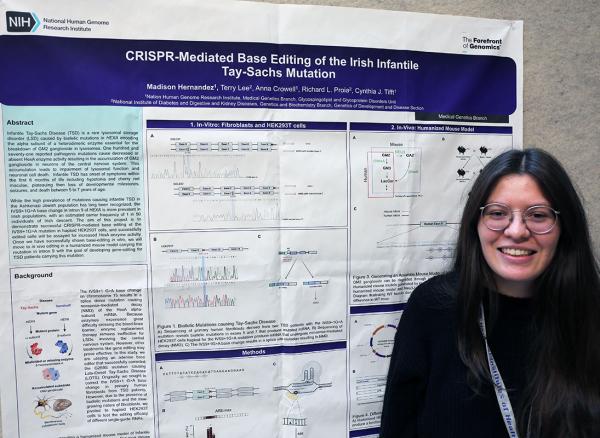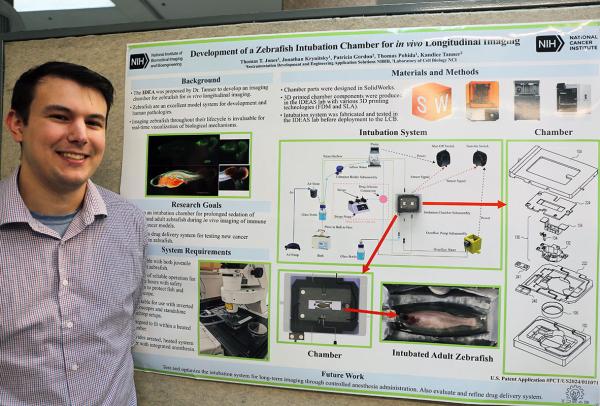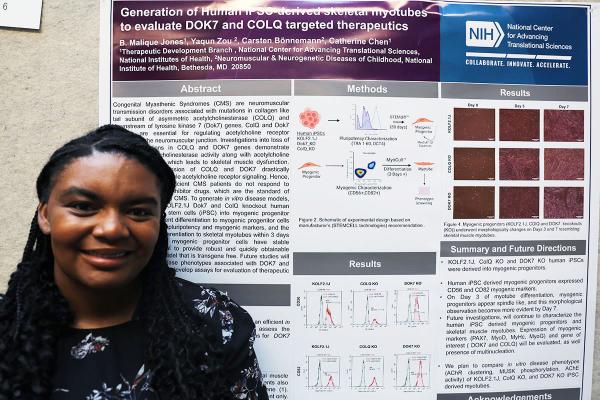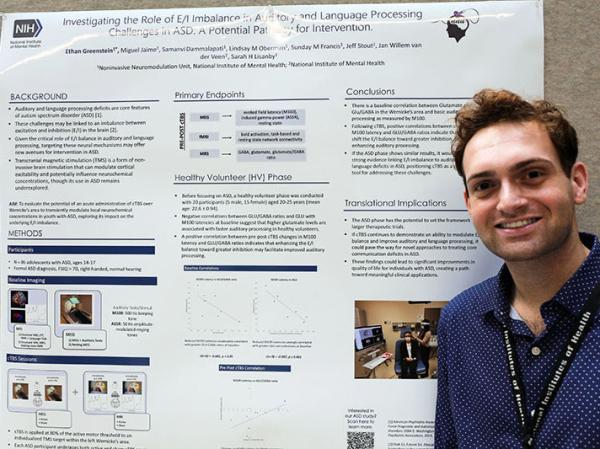Sharing Science at the NIH Research Festival
Poster Sessions Showcase IRP Discoveries
No single event captures the incredible breadth of research going on in the IRP as effectively as the annual NIH Research Festival. In fact, the event is so jam-packed that it typically stretches over multiple days, running this year from September 23-25. The first day of the 2024 Research Festival kicked off with a poster session where scientists from all across NIH showcased the cutting-edge science they have been working on, demonstrating research on subjects like how cooking affects the brain, vaping’s impact on lung health, 3D models for studying pregnancy complications, and much more. Read on to dive deeper into a few of the more than 400 research projects presented at this celebration of IRP science.
Siobhan Lawler: Bringing Neuroscience Into the Kitchen

Many people are inspired to pursue a career in science or medicine by a tragedy that affected themselves or a loved one. However, the event that led to Siobhan’s scientific interest affected many more people than just herself, as she was one of thousands in the area when a pair of men set off home-made bombs at the 2013 Boston Marathon.
“A few years later, I had the chance to revisit conversations with others about their own experiences, which were notably different from mine,” she explains. “This led me to question how individuals experience trauma and inspired my desire to explore the science behind it. That curiosity eventually brought me to NIH, where I am now focusing on learning neuroscience.”
Siobhan brought a unique background to NIH, having completed a Master’s in Social Work prior to getting her first position at NIH through the Graduate Summer Opportunity to Advance Research (G-SOAR) program, which provides graduate students interested in eventually pursuing a Ph.D. with the opportunity to spend a summer working in an IRP lab. Now, after completing her Ph.D. and a postdoctoral fellowship in another NIH research group, she is in the midst of a second postdoctoral fellowship in the lab of IRP investigator Nicole Farmer, M.D., which studies how cooking might help improve people’s mental health and reduce their risk of developing certain illnesses.
“The work we do in our group is highly interdisciplinary, and my expertise in social work plays a critical role in shaping a protocol that would otherwise lack this perspective,” Siobhan says. “My research trajectory is unconventional, which makes it exciting, as I have the opportunity to explore the intersection of social work and neuroscience.”
The particular study Siobhan is working on, called BioCook, aims to determine how cooking affects the bodies and minds of both professional chefs and amateurs. The first step in answering that question requires Siobhan and her colleagues to figure out the best ways to measure the physiological changes that occur when someone is cooking.
“While cooking has been associated with psychological, social, and dietary benefits, most existing research relies on self-reported data and lacks rigorous scientific investigation with objective measurements,” Siobhan explains. “Therefore, the BioCook study aims to fill this gap by employing a multi-modal approach, including EEG, heart rate variability monitoring, sensory system assessments, repeated salivary stress biomarker analysis, and in-depth video-guided interviews conducted after the cooking task.”
Having sampled life in several IRP labs, Siobhan says working with her colleagues in Dr. Farmer’s lab has been especially rewarding. She particularly praises Dr. Farmer herself, who Siobhan says is “deeply invested in my growth, offering the time and expertise to guide me through my fellowship.” Beyond the pleasure she herself gets out of her work, Siobhan is also energized by the public health-focused mission of the IRP as a whole.
“I hold a strong view on the dissemination of scientific knowledge,” she says. “Too often, research is published without effectively reaching the very populations it is meant to help. If our work never reaches those we aim to serve, it begs the question of why we work so hard in the first place. I aspire to help address these inefficiencies for the next generation of scientists, improving how science and treatment are curated both within and outside the NIH, with an emphasis on making an impact at a global level.”
Fun fact: When she was young, Siobhan competed as a competitive swimmer, “one of the crazy ones jumping in an ice-cold pool at four in the morning and then again in the evening, daily, and considering it normal,” she recalls. Over her decade-long swimming career, she won multiple gold medals at the Illinois State Championship, but the announcers repeatedly had difficulty pronouncing her name. In response, Siobhan says, “I made sure everyone in the swimming world knew how to say and spell the Gaelic name, Siobhan. Now, I've gladly taken a backseat to others spreading the uniqueness of my name — but my Starbucks name will always be Mary, just to make life a little easier and speed up the line for those behind me.”
Madison Hernandez: Tackling Tay-Sachs With Gene Editing

Although Madison was able to participate in research as an undergraduate at the University of Texas Permian Basin, she says that she was unable to pursue her “niche” interests until she got the opportunity to work as a postbaccalaureate research fellow under the tutelage of IRP senior clinician Cynthia Tifft, M.D., Ph.D. With Dr. Tifft’s help, Madison was able to conduct research she finds meaningful to her on a personal level.
“I was born with a non-progressive neurological disorder that affects my movement, which ultimately inspired my interest in investigating rare neurodegenerative diseases,” she says. “I grew interested in gene therapy because the idea of correcting a disease at its source fascinated me. When I applied for the NIH postbac program, I contacted Dr. Tifft almost immediately because her interests aligned so closely with mine.”
While Dr. Tifft’s lab studies several rare neurological conditions, the one Madison has been focused on for the past year and a half is Tay-Sachs disease, which is caused by mutations in both copies of the HEXA gene. Without a functional HEXA gene, an enzyme called GM2 ganglioside accumulates in neurons with toxic effects, leading to loss of motor coordination, seizures, and eventually death, often as early as 4 or 5 years of age.
To combat this tragic disease that kills so early in life, Madison is trying to figure out how to use the CRISPR-Cas9 gene editing technique to correct that HEXA mutation. However, unlike traditional CRISPR-Cas9 gene editing, which breaks apart both strands of the DNA molecule before stitching them back together, Madison is instead pursuing an alternate approach called ‘base editing,’ which can correct a single DNA base pair without causing a double-strand break.
“Our findings would provide a proof of concept on base editing for this Tay Sachs mutation, which could later be used to develop a more efficient gene therapy for patients carrying this specific mutation,” Madison explains.
As heartening as it has been for Madison to finally have the resources to conduct research that she relates to personally, she has also had her heart warmed by the interpersonal interactions she has observed while working with Dr. Tifft. One instance that particularly struck a chord was helping to put together a celebratory tea party after one of Dr. Tifft’s patients received an experimental gene therapy treatment.
“Because Dr. Tifft spends a lot of her time caring for patients, I’ve had the incredible opportunity to meet and observe some of them when they come to the NIH for an appointment,” Madison says. “That particular experience felt poetic since an article about the first tea party for one of these patients introduced me to Dr. Tifft’s research nearly two years ago.”
Fun fact: Madison’s family back home in Texas currently has eight dogs, which is actually fewer than the eleven they had at one point while Madison was growing up.
Tommy Jones: Designing a Device to Enable Cutting-Edge Cancer Research

Not everyone doing research at NIH is a white-coated medical doctor or Ph.D. scientist or aspires to become one. While his IRP colleagues treat patients or manipulate tiny cells in petri dishes, Tommy designs and builds new contraptions in NIH’s Instrumentation Development and Engineering Application Solutions (IDEAS) lab.
“The IDEAS section provides engineering expertise to NIH IRP researchers, specializing in the development of first-of-a-kind instrumentation design, software development, in-house fabrication of prototypes, and overall collaborative validation in labs and clinical settings,” he explains.
“I have a background in mechanical engineering with an interest in biomedical research,” he adds. “This led me to seek out labs at NIH that combined engineering expertise with biomedical research, which brought me to the IDEAS section.”
While Tommy’s work differs from what goes on in most NIH labs, it is no less valuable, since many of the studies IRP researchers wish to pursue could not be done without the mechanical know-how of the IDEAS lab. For instance, at this year’s Research Festival, Tommy showed off the design he and his IDEAS colleagues created for a zebrafish sedation chamber that will help scientists in the lab of IRP senior investigator Kandice Tanner, Ph.D., use that model organism to learn about why certain types of cancer spread to specific parts of the body. The chamber can keep zebrafish sedated for the multiple hours required for Dr. Tanner’s team to take images of the fish’s inner workings, and it is compatible with the multiple types of advanced microscopes Dr. Tanner’s team uses. The research also requires that the zebrafish remain alive so that the same fish can be examined in the same way repeatedly.
“Typically, zebrafish imagining is done in short intervals to ensure the fish’s survival,” Tommy explains. “This design enables longer, continuous imaging sessions while preserving the health of the fish. We also designed it to have the ability to look at different developmental stages from younger fish to adults, as all the previous devices were for adults only.”
The IDEAS lab is helping out with many more studies than just Dr. Tanner’s, though. Right now, the group is actively working on over 100 engineering projects in collaboration with researchers all across NIH. Tommy himself contributes to the design and fabrication of multiple projects, and his efforts are made much easier and more fulfilling by everything that he has to work with in the IDEAS lab.
“My experience at NIH has been rewarding thanks to the support and extensive engineering knowledge and resources within IDEAS,” he says. “My favorite part has been working with cutting-edge fabrication technologies such as 3D printing to develop novel instrumentation and devices for clinical research.”
Fun fact: In his spare time, Tommy enjoys golfing. He has been playing since middle school and is constantly searching for new courses to try out.
Malique Jones: Making Muscle Cells in a Petri Dish

Malique has always been curious about the world around us, and fortunately for her, some important people in her life provided the oxygen necessary to turn that spark into a flaming passion for science.
“My excitement for science started at a young age through seeking answers about the environment and the health of others close to me with a simple “Why, Mom?” which led to her funding extracurricular STEM activities,” Malique recalls. “This critical thought matriculated into the classroom and beyond. Furthermore, the pursuit of a scientific research career was fueled by my many mentors at Bennett College, who urged me to pursue both the humanities and scientific research opportunities.”
Those experiences eventually led to graduate school at Michigan State University, where Malique studied inflammation’s effects on muscles in the bladder. Now, as a postdoctoral fellow working in the Therapeutic Development Branch (TDB) of the Division of Preclinical Innovation at NIH’s National Center for Advancing Translational Sciences (NCATS), she is leveraging her experience in the field of muscle biology to develop a sort of ‘muscle-in-a-dish’ model that could help researchers test treatments for a particular set of rare neuromuscular disorders. Under the guidance of TDB associate group leader Catherine Chen, Ph.D., Malique is nurturing induced pluripotent stem cells (iPSCs), which can develop into any other kind of cell found in the body, in a manner that coaxes them to become long cells found in our muscles called myotubes.
“This effort is part of the NCATS Platform Vector Gene Therapy program and establishment of an efficient two-dimensional skeletal myotube model will provide an excellent resource for advancing preclinical testing and gene therapy development for treatment of rare diseases,” Malique explains.
Malique says she is excited to be able to assist with NIH’s health-focused mission and work in a place “where notable impact is being made to ensure the health of patients with rare conditions.” She has particularly enjoyed attending NIH’s annual Rare Disease Day, where she says she was able to “witness the impact and meaning of ‘bench to bedside’ research in real-time.”
“It’s been a great experience and a dream come true,” she says.
Fun fact: Malique is a big fan of spoken word poetry, a passion that she traces back to her aunt and uncle, who hosted a summer camp that provided an opportunity for children to show off their talents. “My talent was always reciting a poem of a great poet or my own,” Malique recalls.
Ethan Greenstein: Addressing Autism’s Auditory Challenges with Brain Stimulation

It makes perfect sense that an organ as vital as the brain is encased in our thick, hard skulls to shield it from the outside world. Unfortunately, this makes it all the more challenging to treat psychiatric conditions by influencing the brain’s electrical firing.
Although Ethan is less than a year out from receiving his undergraduate degree from Washington University in St. Louis, he already has considerable experience trying to tackle this challenge using a technique called transcranial magnetic stimulation (TMS), which uses magnetic fields to alter electrical activity in the brain. Prior to coming to NIH, he worked with the technology during research stints at The George Washington University in Washington, D.C., and Cincinnati Children’s Hospital. Now, with the help of his colleagues in the lab of IRP senior investigator Sarah Lisanby, M.D., Ethan is investigating whether a particular form of TMS might improve how the brains of people with autism spectrum disorder (ASD) process information about sound and spoken language.
“I’ve always been drawn to the idea of leveraging scientific research to solve real-world challenges, particularly in the realm of neurodevelopmental disorders like ASD,” Ethan says. “My previous experiences in research exposed me to the power of neuromodulation as a potential therapeutic tool. When I learned about the cutting-edge research being done in Dr. Lisanby’s lab, especially in the area of non-invasive brain stimulation to more broadly treat mental health conditions, I knew I wanted to be part of the team.”
The study Ethan is working on, known as the DECIBELS study, specifically seeks to use TMS to shift the balance between ‘excitatory’ signals in the brain that activate neurons and ‘inhibitory’ signals that make neurons less likely to fire. Scientists think an imbalance between these two types of signals is what underlies the challenges people with ASD have understanding what is being said to them. Dr. Lisanby’s lab has already seen that its TMS treatment can change the ratios of excitatory and inhibitory chemicals in the brains of cognitively typical individuals, and this was associated with their responding more quickly to sounds. Now, Ethan and his colleagues hope to see similar results when applying the same approach to individuals with ASD.
“This research is important because social communication challenges are a core feature of ASD, and current interventions do not specifically target the underlying neurochemical imbalances that may contribute to these difficulties,” Ethan explains. “By exploring non-invasive brain stimulation as a potential intervention, this study could open new pathways for addressing a key challenge in ASD.”
Though just half a year into his time as a postbaccalaureate fellow in Dr. Lisanby’s lab, Ethan says his experience at NIH has already been “transformative” and “incredibly rewarding.” For him, much of that reward comes from working face-to-face with individuals who have ASD, but he also doesn’t discount the thrill of working with “some of the most advanced tools and pioneering scientists in the field of mental health.”
“I am so grateful to be working with such a diverse, motivated group of individuals united by the collective goal of improving mental health outcomes for all people,” he says.
Fun fact: In his free time, Ethan enjoys running. He ran a half-marathon last year and hopes to run a full marathon in the near future.
Subscribe to our weekly newsletter to stay up-to-date on the latest breakthroughs in the NIH Intramural Research Program.
Related Blog Posts
This page was last updated on Wednesday, October 23, 2024
